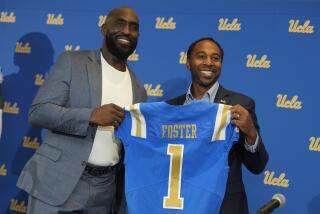Pro Sports Wins Big With Taxpayer Assist
- Share via
These are interesting times in one of the most successful, government-supported U.S. industries: professional sports.
In pro football, the Los Angeles Raiders are moving back to Oakland, whence they came a decade ago, thanks to a local government guarantee of gate receipts to Raiders owner Al Davis and roughly $57 million in improvements to Oakland-Alameda County Stadium that will be financed by tax-exempt bonds. Davis’ deal is being billed as the richest ever in sports--worth more than $600 million in guarantees, fees and payments.
Meanwhile in baseball, the new season remains on hold as owners and players continue a power struggle in which the owners have locked the players out of spring training pending agreement on a new four-year contract. The only item still at issue in the labor conflict--which could be settled this weekend, some experts say--is whether a salary dispute goes to outside arbitration after a player has two years of major league experience or three.
In money terms, that’s no small matter. The average salary for a baseball player with two years in the majors is $219,000, but at three years, with arbitration, the average goes up to $399,000--a difference of $180,000 a year--says Steven Matt, who runs a sports franchise evaluation service for the Arthur Andersen accounting firm.
Still, thousands a year are only details in a business taking in billions. And the eventual labor settlement won’t alter baseball’s traditional profitability, says Michael Megna, an evaluator of franchises for American Appraisal Associates.
Baseball profits may be hidden. Owners get to depreciate the value of player contracts--a standard practice in business, say accountants Pannell Kerr Forster--and so may show a loss for tax purposes. But the profits are real. All teams are making an operating profit today, Matt and other financial experts say.
And the value of sports franchises keeps rising. A group in the Tampa Bay area expects to pay $100 million to land a major league baseball franchise, where the last new entrants to baseball--Toronto and Seattle in the 1960s--paid less than $20 million.
More than ordinary inflation is involved. Media money is gushing in sports; baseball will take in more than $600 million in television and radio revenue this year, 28% more than last year, and pro football’s media haul will rise 73% to $919 million.
Media money plus record attendance revenues and generous tax breaks make sports a business in which everything--expansion, high incomes, luxury accommodations--seems possible and affordable these days.
Yet puzzled fans and taxpaying citizens, alike, ask: Why is that?
A big part of the answer is that sports has become a civic enterprise, like the symphony orchestra or opera company--meaning a business supported one way or another by tax allowances from national and local government.
The day is long past, for example, when team owners built their own arenas. Now they expect local taxpayers to build them, and even to deck them out with special profit-making features such as boxes for wealthy fans. Davis last week cursed Los Angeles politicians for not ponying up public money for such private splendor.
Why do local governments even listen to such bunk? Because sports teams are said to help the local economy. A new study by the University of Cincinnati shows that the Cincinnati Reds baseball team, which had revenue of $42 million last year, generated $135 million in other business by expenditures on local goods and services and by attracting fans from outside the area.
Such multiplier effects exist for any business, explains Gregory Burgess, a member of the university research team, but sports teams and amusement parks may often do more on a local basis than large industrial firms that buy and sell worldwide.
And therein lies big opportunity for revenue growth, says consultant Mark Ganis, president of Chicago’s Sportscorp Ltd., the firm that advised Oakland on how to earn enough from ticket sales to meet its guarantees to Davis and pay off the stadium bonds.
Sports events should charge more for the best seats and boxes, Ganis advises, the way that symphony orchestras charge more for good seats because they give their customers social cachet, calling them patrons and inviting them to exclusive events, not to mention that patrons get tax deductions for their contributions. Ganis understands that social status, political clout and higher prices can be combined in prominent seats at sporting events--plus, of course, tax-deductions for the frequent use of such events as business entertainment. “If business is conducted, the sports event is entitled to a deduction just like restaurant meals,” says Ganis.
So Oakland will charge hefty premiums--$300 and more per season--for choice seats, with federal tax deductions helping to finance the premiums, and the premiums helping to finance the payments on tax-exempt bonds as well as a $29-million-a-year guarantee to Raiders’ owner Davis.
Nor shall Southern California be forsaken: Ganis says he’s working on proposals to build a new municipal stadium in Los Angeles to house the Rams, who now play in municipally owned Anaheim Stadium. Thus, sports as industrial policy apparently has money for all.
Still, some questions arise:
Should a society that regularly turns down tax increases for public schools worry about its priorities when, like the ancient Romans, it gives tax benefits to circuses?
And another:
If sports is a civic enterprise, why is there so much private profit in it? True, wealthy people get tax deductions for backing symphonies, but few get rich owning a symphony orchestra.
In sports, however, Al Davis has become rich on the public purse, and he’s not alone. Call it taxpayer-subsidized free enterprise, one of the nation’s perennial growth industries, unfortunately.
More to Read
Go beyond the scoreboard
Get the latest on L.A.'s teams in the daily Sports Report newsletter.
You may occasionally receive promotional content from the Los Angeles Times.










